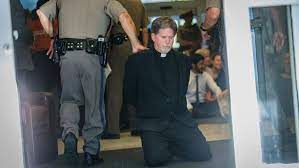I’ve always had a bad attitude when it comes to clergy garb.
In seminary, I used to collect the pictures of clergy in pontifical poses because I thought they were so funny. I loved how Monty Python satirized clergy dressed like roosters trying to act humble. I was once doing a service with a conservative pastor who was hectoring me to wear a robe, but I was refusing to wear one until my LGBTQ colleagues could be ordained. The clergyman blurted out, “I wear the robe because this isn’t about me.” “Yeah,” I thought, “nothing helps you blend into a group of ordinary folk like 15th century garb.”
So, when I was preparing to be arrested at a protest a few years back, my friend, the Reverend Babs Miller came to the office with a black clergy shirt and collar. My memory is a bit vague, but it seems to me she said, “You need to wear this.” My first thought was, “hell, no!” but I thankfully I did not say that out loud.
My fear was that people would see the collar and think I was claiming special status in a sect that excluded many people who would be at the event. But I knew Babs had worn that shirt as a hospice chaplain. She wore it as a witness to dying people that they were loved even if they had been rejected by their churches and families. I knew Rev. Babs had also worn that shirt when she “came out” on the floor of Presbytery and called for justice for LGBTQ people within the church.
Babs said, “This shirt and collar is a reminder of the message that are all loved. The press is going to take pictures and you need to communicate the message visually.” I wasn’t convinced but I showed up to get arrested wearing Bab’s black shirt and clergy collar. Perhaps knowing the garb had belonged to a lesbian minister helped me feel the subversive nature that symbols can have when taken from the powerful and given on behalf of those the church itself will sometimes betray.
Bab’s words reminded me a bit of Johnny Cash’s song “Man in Black:” ”
I wear the black for the poor and the beaten down, livin’ in the hopeless, hungry side of town, I wear it for the prisoner who has long paid for his crime, but is there because he’s a victim of the times.”
When the arrest finally happened, it all felt a bit surreal. The arresting officer had me kneel. We were inside the building and could not see the press, but could hear the furious flashing of unseen cameras sounded like thunder. That picture of me kneeling in clergy garb showed up in newspapers all over the world. The picture of a minister getting arrested in that collar seemed to communicate that the crisis at the border had greater spiritual implications. Even when I was interviewed on Tucker Carlson, I could tell he was thrown off by the collar. God knows what he would have done if he realized it really belonged to a lesbian clergy.
Babs had been right. Wearing her magic lesbian clergy collar had served as a reminder of the voices that really needed to be heard. The collar could serve as placeholder for the child drinking leaded water in Flint Michigan drowning in the fetid swamp of under regulated capitalism. The collar could serve as a placeholder for battered spouses told by the church to submit to their abusers. The collar could serve as a placeholder for the forgotten souls who rot in America’s vast prison industry.
On this day I clearly felt myself to be a mere placeholder for mistreated undocumented immigrants whose righteous cries for justice were not being heard.
After the arrest, Babs gave me her magic clergy collar. I still hate religious garb pretty passionately, but I wear the collar when someone’s humanity is on the line. To me, the collar serves as a reminder of every single person the church has excluded and whose humanity this nation has betrayed. The collar serves as one denomination’s reminder of that higher love to which we are all called- that love which is bigger than any of us, yet includes us all.
(Story first posted March 2024, Picture credit to Austin American Statesman.)
